An in-person Study of the Costa Rican Nicoya Peninsula “Blue Zone” & how you can apply their “Long-Being and Well-Being” behaviours into your everyday lives. This is PART I of III
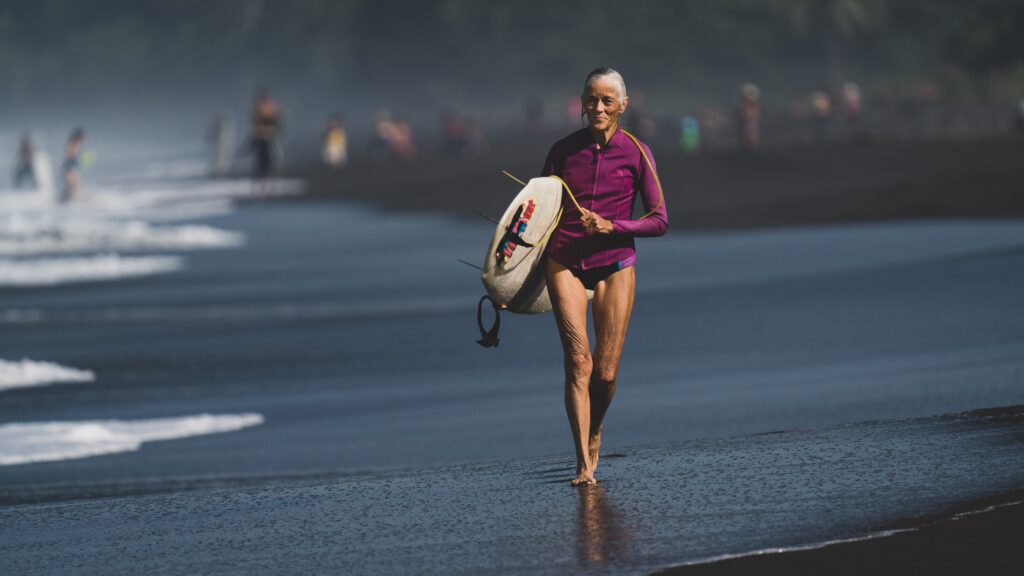
So, what is a Blue Zone and where are they?
Blue Zones are areas of the world where people live longer, and enjoy those years in greater health comparatively to the poorer health-spans of aged populations in many OECD countries. They have disproportionate numbers of people who live to be over 90 and 100, while remaining active , compared to some of the more obvious regions with greater wealth and access to good health care services. In this post part I, II and III, we’ll explore the unique characteristics of the Nicoya region that I observed on my recent trip to Costa Rica, and later suggest ways you can adapt and incorporate some of their practices into your daily life – despite the obvious environmental and cultural differences.
First off, let’s dive into where exactly the Blue Zones are. There are five regions around the world that have been identified as having higher concentrations of people who live well to an older age. These include parts of Italy (Sardinia), Greece (Ikaria), Japan (Okinawa), Costa Rica (Nicoya Peninsula) and Loma Linda, California. While there are some differences between each region, they do share several lifestyle habits that overlap which are well documented. My interest was to see if these are still relevant, and, what if anything has changed or threatening these lifestyle characteristics. I then wanted to distill these learnings into meaningful ways anyone can apply them to benefit their daily life and long term health outcomes.
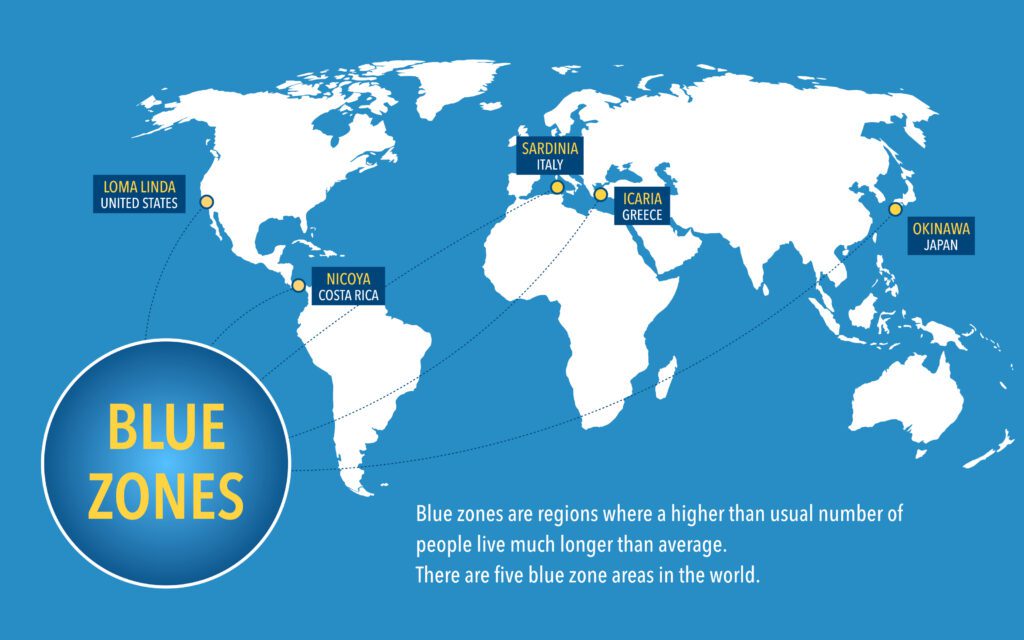

Costa Rica/The Nicoya Peninsula
Costa Rica is still considered a “developing” country, ranked 70th in the world with a GDP-PPP per capital of $24,490 (1) It makes sense to most of us that developed countries with wealth creation, provide ubiquitous access to health services for the majority of their people; better income = better outcomes, right? Not necessarily. Costa Rica is an exception – despite spending only a fraction of what their USA neighbour does on health care and having a per capita income of approximately one sixth, they are now outliving their neighbours.
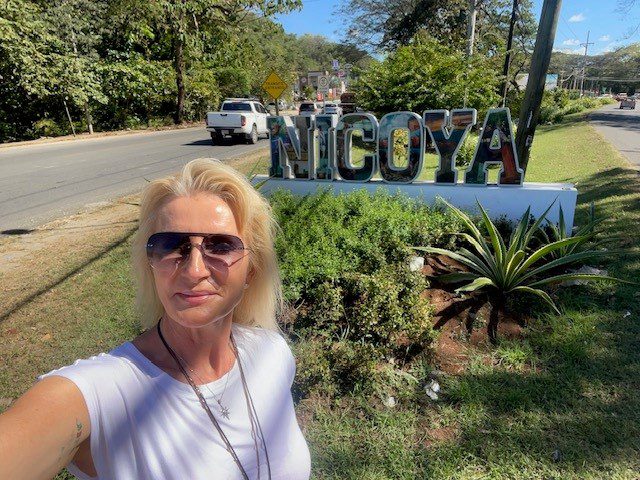

Author arriving in the peninsula Jan 2023
The Nicoya Peninsula lies on the western side of Costa Rica, with numerous beautiful beaches on the Pacific Coast, and offers many nature and wildlife reserves making it a popular destination for both tourists and recent re-patriated Americans. It is this particular area of Costa Rica that has a high number of residents living over 90 and 100 whilst remaining active. I was invited to join the community of La Delicias which is approximately a 25-minute drive South East of the famous Nosara Beach. The community originally evolved over 100 years ago and boasts a modest population of approximately 400
The Community of La Delicia – Nicoya Peninsula
One of the first things I noticed was the soft blend of nature & habitation: rainforest, hills, meadows, all with a subtle presence of relevant technology. (cabling, aerials and satellite dishes). Houses are built on generous sites, most of which are planted or landscaped to offer large outdoor living areas to enjoy sun, shade and soaking up the beautiful wildlife. Quad bikes were parked alongside tethered horses. Recycling reminders and provided bins create a clear presence to support their committed protection of the ecosystem. Community gardens, multiple gathering spaces, including an outdoor communal gym, next to a large soccer field are all connected to the small laneways and houses. There is a lot of shared recreation, and easy access to the outside world but residents can easily choose to stay immersed in their rich “naturescape”.
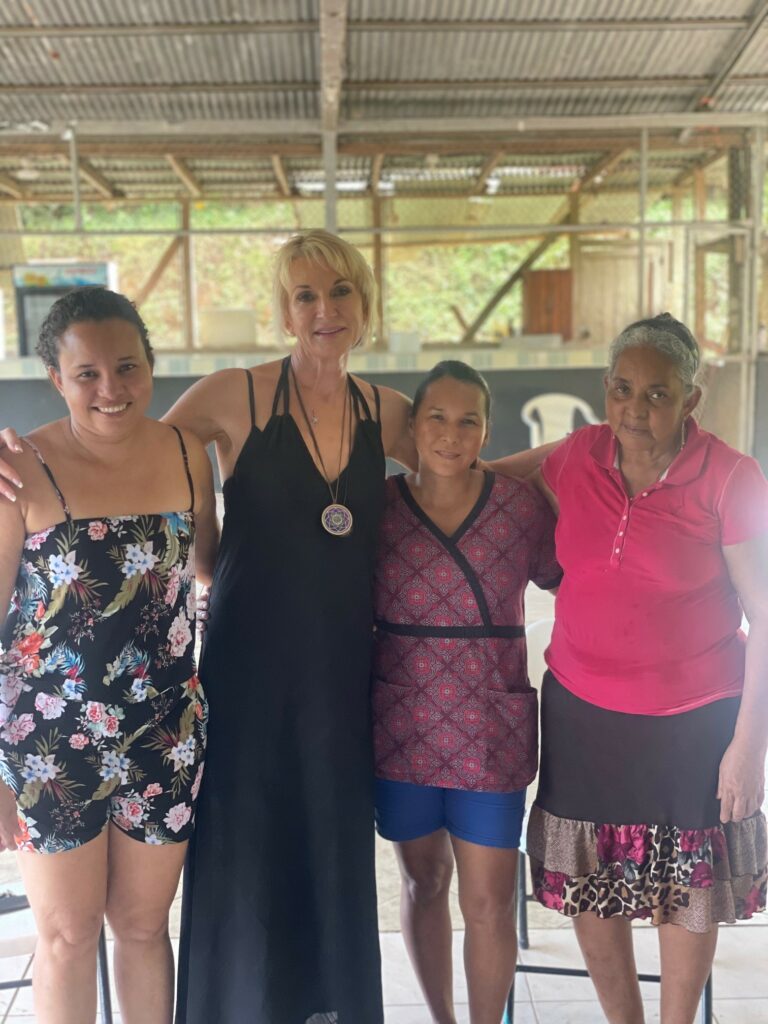

The community leaders of La Delicia from left to right: Efolia (President) Author, Joelina, and Santos


Spending time in La Delicias revealed many of the obvious lifestyle factors I would have expected from my initial research – but also some surprises. In the interest of time and space, I am going to summarise the top three here, in part II, I’ll cover the balance, and in part III – I will add in some unexpected wisdom and outcomes discovered while talking with the leaders and explore how you could adapt some of their default lifestyle habits into your own daily life.
Nutrition – Food & Water
“La Delicians” care about what they eat and how they eat. Large shared gardens offer organically grown fruits and vegetables. They are not vegetarian as many might expect but definitely don’t eat meat every day. They enjoy lots of fruits, vegetables, beans, pulses and rice, high fibre & low Glycemic index foods, quite a Mesoamerican based diet. (The fruit is delicious in Costa Rica given the ample sun and rainfall, and its worth the flight just to try ‘Granadilla’ which is a giant sweet passionfruit with huge amounts of pulp!) They eat little processed food, and there is no presence in this area or the local town, Nosara, of fast-food outlets. I found it easy to follow a plant-based preference in all of Costa Rica. Although, I noted with concern a few of the better-known USA fast-food outlets had crept into the major cities.
The way they eat is equally as important as what they eat – most meals are shared, and prepared to be enjoyed. They are not cooked at high temperatures; food is eaten slowly and no one eats to be “full”. Breakfast is still traditionally the most important meal, with the work day ahead, and dinner is generally the lightest meal of the day if at all.
The Water in La Delicia is believed by the locals to be a critical factor to their health. The quality of their water which is from an aquifer is very pure – the well (which they no longer use is over 100 years old) – they now use a pump. The locals were so resolute about water quality that I quickly bought myself a distiller on returning home. Their water has naturally high levels of magnesium and calcium. They drink little alcohol, access and cost create reasonable barriers & they would rather be outdoors socialising and playing sports or watching the children play.
Community/Connection
I was presented with a lot of research at a medical conference in California Oct 2022 that had closely monitored Breast Cancer patients recovery alongside their nutritional , exercise and social support patterns and habits. I was astonished at the impact isolation/lack of connection had on poor outcomes including recurrence and metastasis. Isolation was also tied into higher rates of Cardio vascular disease , anxiety and depression, the latter two which were causative in themselves of poor health outcomes. Community and connection is everything at La Delicia. As a small population which has a church, and a school (4-12 yrs) it boasts a large community centre – most celebrations are held there including special birthdays. Everyone is included & expected. There just isn’t a time when people who live here feel “alone”. Most aging residents live with families and grandchildren, and if not they are visited frequently by other members. They have a robust structure serving as a guiding watchdog of the community as a whole, including the youth, the church and the school. What I witnessed was as real unity to protect and support all residents, their eco system, and a lot of forward thinking. As Costa Rica became a popular destination not only for tourists but expats wanting to live there, they bought technology with them , in particular, quad bikes, motor bikes and motor vehicles. The council of this small community quickly realised that as horse back travel and walking was slowly diminishing , they needed to keep their people active and strong. They funded and built an outdoor gym, with a childs playground, that is also attached to a large soccer field. At any given time community members can exercise while supervised children play. They are all outdoors, surrounded by nature, getting their incidental activity and connecting with each other.
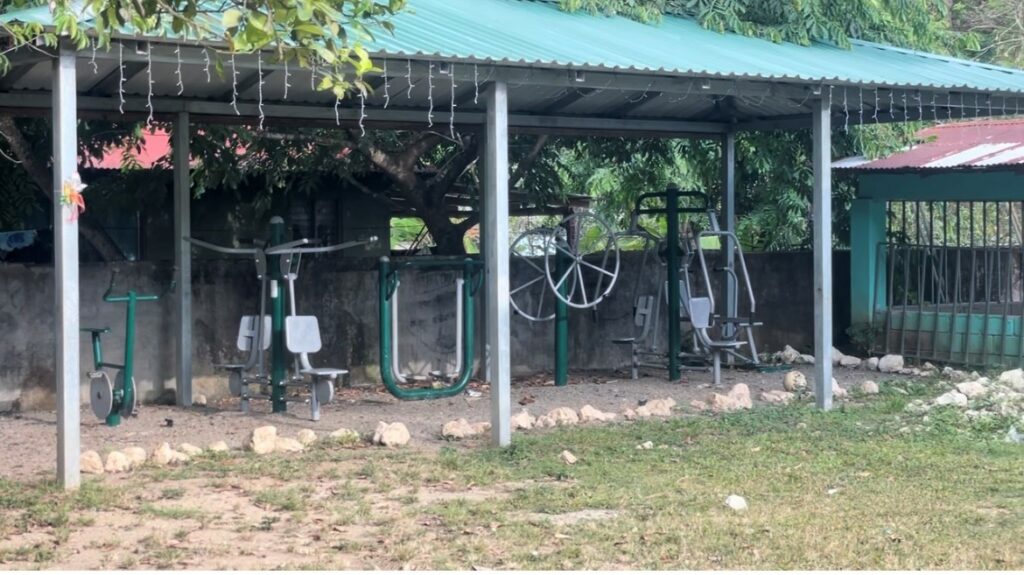

The Forward thinking community built the outdoor gym to combat the introduction of vehicles. More efficient transportation means an improvement and adaptation to their lifestyle, including transporting the older children to mainstream schools, and wider work opportunities for them all, but maintaining fitness and strength, while “coming together” is a priority.
Life Purpose “Plan De Vida”
What seems to keep the over 90 plus thriving, is having a strong sense of Purpose or “Plan De Vida”. “Plan De Vida” means life or soul purpose and sometimes that is translated to simply mean “its why we wake up in the morning” . ( we will look at how to create your own Plan De Vida” in part II) While some planning goes into the community infrastructure and future protection of their people and ecosystem – the individuals life purpose appears to be lived out on a daily basis. The members here are not materialistic, and it was explained to me that they feel many of the trappings of the developed modern world distract and blind us to our true purpose. Strong faith, traditions and belief in the power of collective good seem to keep them peacefully moving forward to their true north. Many do physical work well into their 80’s and older. The Elders are well thought of and sought out for their counsel and wisdom. There is much respect for the legacy of the aging in Costa Rica. The community relies on their older population to uphold and pass on the many traditions of their customs and way of life. If you happen to google “retirement villages Costa Rica” – you will learn that these have been created largely for foreigners. The elderly population in Nicoya are celebrated and feel “needed”. When I think of what I believe creates and keeps momentum in a sense of purpose, I come back to the paradigm of “adding value and feeling valued” I came away with a clear sense that it was the “Plan De Vida” and tight community/connection that was supporting much of the longevity and wellness in La Delicia. This supports some research I did before travelling.
Absence of prolonged or Acute Stress (Biological Aging – Telomeres)
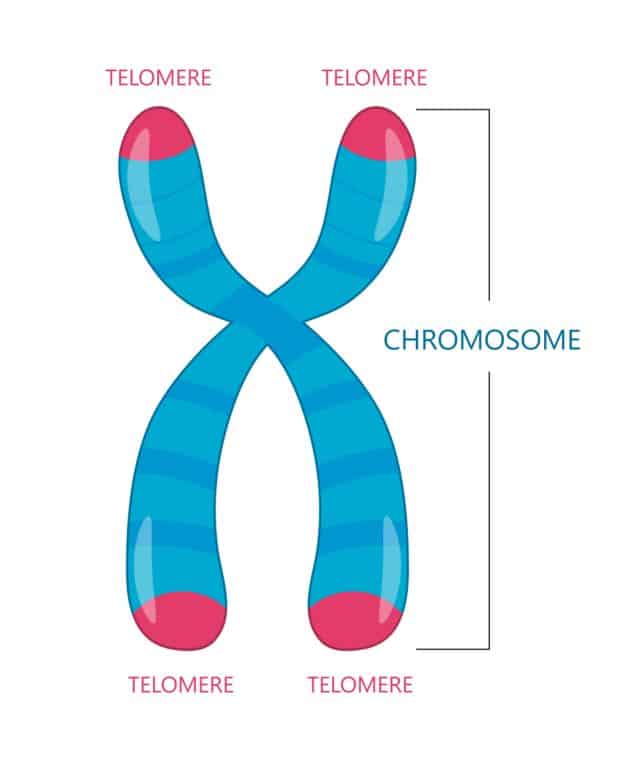

I read an interesting population study before I went to Nicoya. (2) “Longer leukocyte telomere length in Costa Rica’s Nicoyan Peninsula: A population-based study” by Stanford Epidemiologist David Rehkopf – the link is at the base with other references. Telomeres as a phrase is being bandied about freely these days as a measurable indication of a persons longevity. Defined very simply they are the ends of a chromosome, and they protect it from becoming frayed. Each time a cell divides, the telomeres become slightly shorter. Eventually, they become so short that the cell can no longer divide successfully, and the cell dies. So longer telomeres for less degradation is a good thing . ( and YES you can lengthen your Telomeres, and adaptation of some of the Blue zone lifestyles is a great start!)
The study identified that the population on the Nicoya Peninsula had substantially longer telomeres in their immune cells compared to other parts of Costa Rica . That particular study didn’t conclude the exact cause: genetic or environmental or both. When I talked to the leaders of La Delicia about general health and prescribed medications, they were not aware of any members that are, or were on anti-anxiety or depression medications. In fact, there were a few raised and confused eyebrows when I mentioned it. Collaboration and support appears to offer a possible explanation. No-one is on their own. Problems don’t become stressors as they are resolved collectively. Isolation, and loneliness are not features of Nicoyan life. The Segway I am making here is to multiple studies on exposure to acute stress being partly causative of shortening Telomeres. Managing your pace of life, having a clear life purpose, and the handling of issues as they rise collectively, that is, feeling connected and supported at work and in your personal life, are strong themes that are coming through as being elementary in emotional well-being from my observations around the globe, and these positives are very present in everyday life in La Delicia. This was a specific study of a small community within the Nicoyan Peninsula and there are differences between Costa Rica as a population and this region. Both however have a number of factors that as a country have them scoring better in their key health markers than their bigger and wealthier neighbours. Costa Rica has a community versus centralised health care system that has provided excellent health records including birth and death data. We will have a look at that in part II. I will also explain the concerns of the community in maintaining their health status and what they feel the potential disruptors are.
Part II will be published March 7th
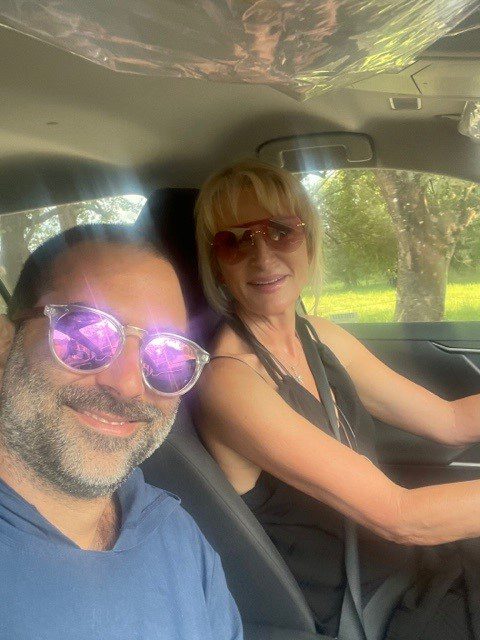

I want to acknowledge my very kind and patient translator Vram (Milan) for his respectful and detailed work. To the residents and leaders of La Delicia – for their openess and generosity, in making this possible. Gracias desde el fondo de mi corazon
(1) International Monetary Fund, World Economic Outlook April 2022.
(2) Longer leukocyte telomere length in Costa Rica’s Nicoya Peninsula: a population-based study; Nov 2013, National Library of Medicine
